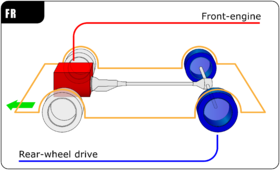| Revision as of 15:32, 13 July 2004 editSfoskett (talk | contribs)Extended confirmed users26,722 editsNo edit summary |
Latest revision as of 18:34, 23 November 2024 edit undoVola31 (talk | contribs)28 editsmNo edit summary |
| (299 intermediate revisions by more than 100 users not shown) |
| Line 1: |
Line 1: |
|
|
{{Short description|Automobile layout}} |
|
In ] design, an '''FR''', or '''Front-engine, ]''', layout places the ] in the front of the vehicle and drive wheels at the rear. This was the traditional automobile layout for most of the 20th century. This layout is typically chosen for its simple design and weight distribution. Placing the engine at the front gives the vehicle a traditional long hood. Placing the drive wheels at the rear allows ample room for the transmission in the center of the vehicle. |
|
|
|
{{Multiple issues| |
|
|
{{original research|date=January 2023}} |
|
|
{{more references|date=January 2023}} |
|
|
{{Single source|date=April 2019}} |
|
|
}} |
|
|
] |
|
|
|
|
|
|
A '''front-engine, rear-wheel-drive layout''' '''(FR)''', also called '''Systeme Panhard'''<ref name="R-MH">{{cite web |title=The Nostalgia of Forgotten Gods: Panhard & Levassor, France, 1886-1967 |url=https://roarington.com/media-house/stories/the-nostalgia-of-forgotten-gods-panhard-and-levassor-france-1886-1967 |website=Roarington |access-date=26 August 2024 |language=en}}</ref> is a ] with an engine in front and ], connected via a ]. This arrangement, with the engine straddling the front axle, was the traditional automobile layout for most of the pre-1950s automotive mechanical projects.<ref>{{cite web|url=http://www.sae.org/technical/papers/2006-01-1339|title=Development of a New Hybrid Transmission for RWD Car|publisher=www.sae.org|access-date=2008-01-11|archive-url=https://web.archive.org/web/20090207074723/http://www.sae.org/technical/papers/2006-01-1339|archive-date=2009-02-07|url-status=dead}}</ref> It is also used in trucks, pickups, and ] ]es and ]es. |
|
Most cars used the FR layout until the 1980's, exemplified by the ], ], and vehicles from ] and ]. The ] of the 1970's and the success of small ] cars like the ] and ] led to the widespread adoption of that layout. Today, most cars are FF, though the limitations of that layout are beginning to become apparent. Many of the newest models have adopted ], and some, like the ] are switching back to the FR layout. Most ] and ] have been FR since the beginning. |
|
|
|
|
|
|
|
=={{anchor|FMR layout|FMR}}Front mid-engine, rear-wheel-drive layout== |
| ⚫ |
See also: |
|
|
|
[[File:Automotive diagrams 03 En.png|thumb|upright=1.25|FMR |
|
* ] |
|
|
|
layout, the engine is located behind the front axle]] |
|
* ] |
|
|
|
|
|
* ] |
|
|
|
A '''front mid-engine, rear-wheel-drive layout''' '''(FMR)''' places the engine in the front half of the vehicle but ''behind'' the front axle, which likewise drives the rear wheels via a driveshaft. Shifting the engine's ] rearward aids in front/rear ] and reduces the ], both of which improve a vehicle's ].{{citation needed span|While the mechanical layout of an FMR is substantially the same as an FR car, the classification of some models of the same vehicle may vary as either FR or FMR depending on the length of the engine (e.g. 4-cylinder vs. 6-cylinder) and its center of mass in relation to the front axle.|reason=It is a boldface potentially contentious claim without any support.|date=January 2023}} |
|
* ] |
|
|
|
|
|
* ] |
|
|
|
FMR cars are often characterized by a long hood and front wheels that are pushed forward to the corners of the vehicle, close to the front bumper. ]-style ]s often have FMR layouts, as a rear engine does not leave much space for rear seats. |
|
* ] |
|
|
|
|
|
|
==Gallery== |
|
|
<gallery> |
|
|
File:1968 AMC AMX yellow 390 auto md-er.jpg|The 390 cid V8 engine in a FR 1968 ] functionally straddles its front axle, with the centerline of the shock towers basically bisecting the center of the air cleaner |
|
|
E-Type Jag 4.2-litre engine 2022.jpg|The straight-6 DOHC ] clearly sits behind the front axle of an FMR ] |
|
|
GMLT5.JPG|All ] from the second through the seventh generation are FMR. Only ancillary aspects of this ] engine may lie above the front axle. |
|
|
Dodge Viper Motorraum.JPG|An FMR ] showing its 8.4 L V10 positioned behind the car’s front axle |
|
|
F_599_007.JPG|The ] V12 engine sitting behind the ]'s front axle. |
|
|
</gallery> |
|
|
|
|
⚫ |
==See also== |
|
|
*] |
|
|
|
|
|
==References== |
|
|
{{reflist}} |
|
|
|
|
|
{{Automobile configuration}} |
|
|
|
|
|
{{DEFAULTSORT:Front-Engine, Rear-Wheel Drive Layout}} |
|
|
] |
FMR cars are often characterized by a long hood and front wheels that are pushed forward to the corners of the vehicle, close to the front bumper. 2+2-style grand tourers often have FMR layouts, as a rear engine does not leave much space for rear seats.


 The 390 cid V8 engine in a FR 1968 AMC AMX functionally straddles its front axle, with the centerline of the shock towers basically bisecting the center of the air cleaner
The 390 cid V8 engine in a FR 1968 AMC AMX functionally straddles its front axle, with the centerline of the shock towers basically bisecting the center of the air cleaner
 The straight-6 DOHC XK engine clearly sits behind the front axle of an FMR Jaguar E-Type
The straight-6 DOHC XK engine clearly sits behind the front axle of an FMR Jaguar E-Type
All Chevrolet Corvette from the second through the seventh generation are FMR. Only ancillary aspects of this Chevrolet Corvette ZR-1's engine may lie above the front axle.
An FMR Dodge Viper showing its 8.4 L V10 positioned behind the car’s front axle
The F140 C V12 engine sitting behind the Ferrari 599's front axle.